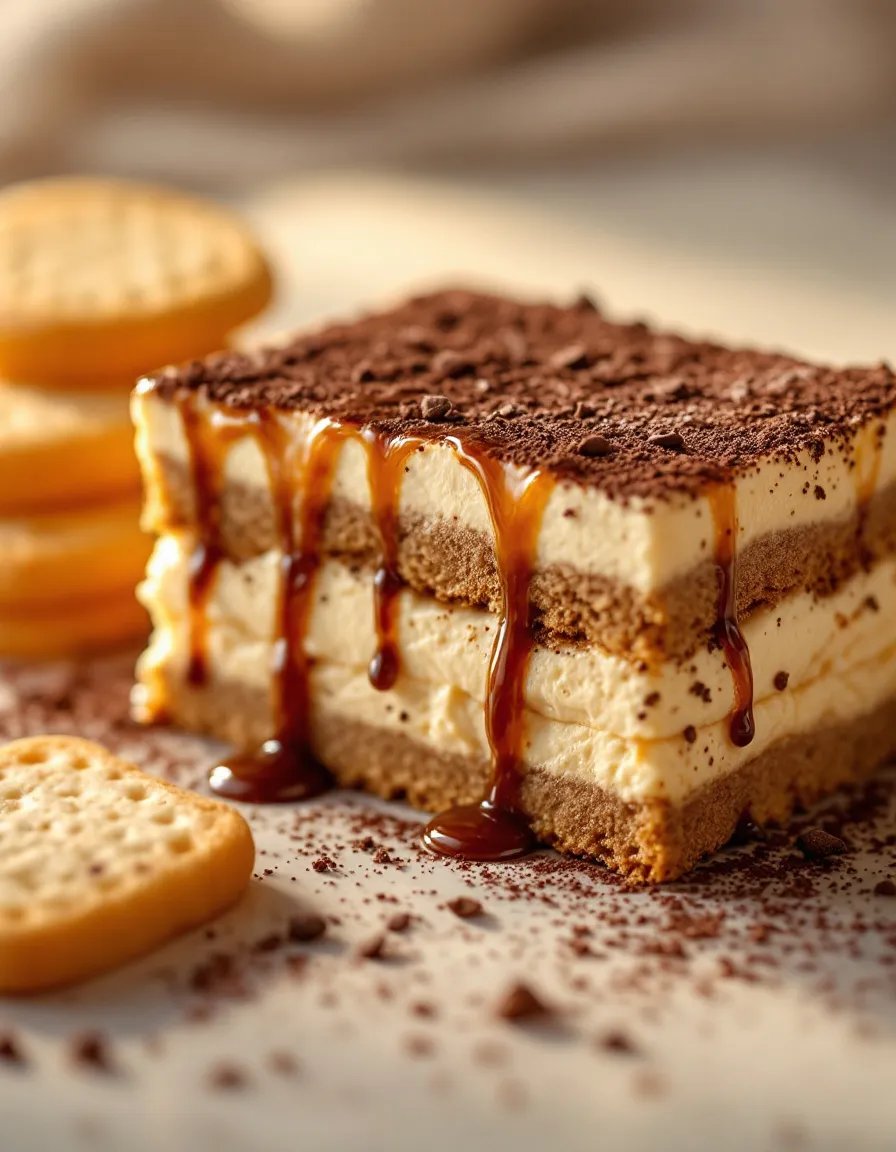Limoncello Cake: A Zesty Italian Delight
Indulge in the vibrant flavors of Italy with this Limoncello Cake, a dessert that perfectly balances the tangy zest of lemons with the sweet, creamy richness of a moist cake. This recipe is a celebration of Italian culinary tradition, bringing a touch of Mediterranean sunshine to your table. Whether you’re hosting a summer soirée or simply craving a refreshing treat, this cake is sure to impress.
The Limoncello Cake is a delightful combination of fluffy sponge, tangy lemon curd, and a smooth Limoncello glaze. Each bite offers a burst of citrusy freshness, complemented by the subtle warmth of the Limoncello liqueur. The cake’s golden hue and glossy finish make it a visually stunning centerpiece for any occasion. Perfect for lemon lovers, this dessert is both elegant and approachable, making it a must-try for bakers of all skill levels.
Quick Recipe Highlights
- Flavor Profile: A harmonious blend of tangy lemon and sweet Limoncello, with a hint of vanilla.
- Texture: Light and fluffy sponge with a creamy lemon curd filling and a smooth glaze.
- Aroma: Fresh citrus notes with a subtle hint of Limoncello’s warmth.
- Visual Appeal: Golden cake with a glossy glaze, garnished with lemon zest and fresh berries.
- Skill Level Needed: Intermediate, with some baking experience recommended.
- Special Equipment: Stand mixer or hand mixer, zester, and a bundt pan.
Recipe Overview
- Difficulty Level: This recipe is perfect for intermediate bakers who are comfortable with techniques like folding and glazing.
- Category: Dessert, perfect for celebrations or afternoon tea.
- Cuisine: Italian-inspired, with a modern twist on traditional flavors.
- Cost: Moderate, with most ingredients being pantry staples.
- Season: Ideal for spring and summer, but can be enjoyed year-round.
- Occasion: Great for birthdays, dinner parties, or as a special treat.
Why You’ll Love This Recipe
The Limoncello Cake is a showstopper that combines bold flavors with a light, airy texture. The tangy lemon curd filling adds a delightful contrast to the sweet sponge, while the Limoncello glaze provides a sophisticated finish. This cake is not only delicious but also visually stunning, making it perfect for special occasions or as a centerpiece for your dessert table.
One of the best things about this recipe is its versatility. You can easily adapt it to suit different dietary needs or flavor preferences. Whether you’re a fan of citrus desserts or looking to try something new, this cake is sure to become a favorite. Plus, the use of Limoncello adds a unique twist that sets it apart from traditional lemon cakes.
From a nutritional perspective, this cake offers a good dose of vitamin C from the fresh lemons, and the use of Greek yogurt in the batter adds a touch of protein. While it’s still a treat, it’s a slightly healthier option compared to many other desserts. The balance of flavors and textures makes it a satisfying choice for anyone with a sweet tooth.
Socially, this cake is a conversation starter. Its vibrant flavor and elegant presentation make it a hit at gatherings, and it pairs beautifully with a variety of beverages. Whether you’re serving it at a formal dinner party or a casual get-together, it’s sure to impress your guests.
Cost-wise, this recipe is relatively affordable, especially if you already have Limoncello on hand. The ingredients are simple and easy to find, making it an accessible option for home bakers. Plus, the cake’s impressive appearance and taste make it feel like a luxury dessert without the high price tag.
Historical Background and Cultural Significance
The origins of Limoncello Cake can be traced back to the Amalfi Coast of Italy, where Limoncello liqueur is a beloved staple. Limoncello itself has a rich history, dating back to the early 20th century when it was first crafted by local families using the region’s abundant lemons. The liqueur’s bright, citrusy flavor quickly gained popularity, and it wasn’t long before it found its way into desserts.
In Italian culture, Limoncello is often enjoyed as a digestif after meals, but its versatility has led to its incorporation into various culinary creations. The Limoncello Cake is a modern interpretation of traditional Italian desserts, blending the classic flavors of lemon and Limoncello with contemporary baking techniques. This cake is a testament to the enduring appeal of Italian flavors and their ability to adapt to new culinary trends.
Over the years, the recipe has evolved, with bakers adding their own twists to the classic formula. Some versions include a layer of lemon curd, while others feature a Limoncello-infused glaze. Despite these variations, the essence of the cake remains the same: a celebration of the vibrant, zesty flavors that define Italian cuisine.
Today, the Limoncello Cake is enjoyed worldwide, a testament to the global love for Italian-inspired desserts. Its bright, refreshing flavor and elegant presentation make it a favorite for special occasions, and its cultural roots add a layer of authenticity that sets it apart from other desserts.
Ingredient Deep Dive
Lemons
Lemons are the star of this recipe, providing the vibrant citrus flavor that defines the Limoncello Cake. Rich in vitamin C and antioxidants, lemons offer numerous health benefits, including boosting immunity and aiding digestion. When selecting lemons, choose ones that are firm, heavy for their size, and have a bright, smooth skin. Store them in the refrigerator to maintain freshness, and always zest them before juicing for maximum flavor.
If fresh lemons are unavailable, you can substitute bottled lemon juice, though the flavor may be slightly less vibrant. For the zest, dried lemon peel can be used in a pinch, but fresh zest is always preferred for its bright, aromatic qualities.
Limoncello
Limoncello is an Italian lemon liqueur that adds a unique depth of flavor to this cake. Traditionally made from the zest of Sorrento lemons, alcohol, water, and sugar, Limoncello has a sweet, tangy taste that complements the citrus notes in the cake. When choosing Limoncello, opt for a high-quality brand to ensure the best flavor. Store it in the freezer for a refreshing after-dinner drink or to keep it chilled for baking.
If you don’t have Limoncello, you can make a simple substitute by combining lemon zest, vodka, and sugar, though the flavor profile will be slightly different. Alternatively, you can use another citrus liqueur, such as Cointreau, though this will change the cake’s flavor profile.
Greek Yogurt
Greek yogurt is used in the batter to add moisture and a slight tanginess to the cake. It also contributes to the cake’s tender crumb and helps balance the sweetness of the glaze. Greek yogurt is a good source of protein and probiotics, making it a healthier alternative to sour cream or buttermilk. Choose plain, unsweetened Greek yogurt for the best results, and ensure it’s at room temperature before mixing it into the batter.
If Greek yogurt is unavailable, you can substitute it with an equal amount of sour cream or buttermilk. Both options will provide similar moisture and texture, though the flavor will be slightly different.
Common Mistakes to Avoid
- Overmixing the batter: This can lead to a dense, tough cake. Mix just until the ingredients are combined.
- Using cold ingredients: Ensure all ingredients are at room temperature to achieve a smooth, even batter.
- Overbaking: Check the cake a few minutes before the recommended time to prevent dryness.
- Not greasing the pan properly: This can cause the cake to stick and break when removing it from the pan.
- Skipping the lemon zest: The zest adds essential oils that enhance the lemon flavor.
- Using low-quality Limoncello: A good-quality Limoncello makes a significant difference in flavor.
- Not letting the cake cool before glazing: This can cause the glaze to melt and slide off.
- Overloading the cake with glaze: A thin, even layer is all you need for the perfect finish.
Essential Techniques
Folding
Folding is a gentle mixing technique used to incorporate delicate ingredients, such as whipped egg whites, into the batter without deflating them. To fold, use a spatula to cut through the center of the mixture, then sweep it along the bottom and up the side, turning the bowl as you go. Repeat until the ingredients are just combined. This technique ensures a light, airy texture in your cake.
Glazing
Glazing adds a glossy finish and an extra layer of flavor to the cake. To achieve a smooth glaze, ensure the cake is completely cool before applying it. Use a spoon or piping bag to drizzle the glaze evenly over the cake, allowing it to drip down the sides. For a thicker glaze, let it sit for a few minutes before serving.
Pro Tips for Perfect Limoncello Cake
- Use fresh, high-quality lemons for the best flavor.
- Zest the lemons before juicing to capture the essential oils.
- Ensure all ingredients are at room temperature for a smooth batter.
- Don’t overmix the batter to maintain a light, fluffy texture.
- Let the cake cool completely before glazing to prevent melting.
- Use a bundt pan for an elegant presentation.
- Garnish with fresh berries and lemon zest for a pop of color.
Variations and Adaptations
Gluten-Free
To make a gluten-free version, substitute the all-purpose flour with a gluten-free flour blend. Ensure the blend contains xanthan gum for the best texture. You may also need to adjust the baking time slightly, as gluten-free cakes can bake faster.
Vegan
For a vegan adaptation, replace the eggs with flax eggs (1 tablespoon ground flaxseed mixed with 3 tablespoons water per egg) and use a plant-based yogurt. Substitute the butter with vegan margarine or coconut oil, and ensure the Limoncello is vegan-friendly.
Low-Sugar
To reduce the sugar content, use a sugar substitute like erythritol or stevia in the batter and glaze. Be mindful that the texture and sweetness may vary slightly, so adjust to taste.
Serving and Presentation Guide
Serve the Limoncello Cake at room temperature for the best flavor and texture. Slice it into even portions using a sharp knife, and garnish each slice with a twist of lemon zest or a few fresh berries. For an extra touch of elegance, dust the cake with powdered sugar before serving.
Pair the cake with a glass of chilled Limoncello or a cup of herbal tea for a delightful dessert experience. If serving at a party, consider adding a scoop of vanilla ice cream or a dollop of whipped cream on the side for added indulgence.
Wine and Beverage Pairing
The Limoncello Cake pairs beautifully with a variety of beverages. For a classic Italian experience, serve it with a glass of chilled Limoncello or Prosecco. The sparkling wine’s acidity complements the cake’s citrus notes, while the Limoncello enhances its flavor.
For non-alcoholic options, consider pairing the cake with a cup of Earl Grey tea or a refreshing lemonade. The tea’s bergamot notes harmonize with the lemon flavors, while the lemonade provides a refreshing contrast.
Storage and Shelf Life
Store the Limoncello Cake in an airtight container at room temperature for up to 2 days. For longer storage, refrigerate it for up to 5 days. Allow the cake to come to room temperature before serving to restore its texture and flavor.
To freeze, wrap the cake tightly in plastic wrap and place it in a freezer-safe container. It can be frozen for up to 3 months. Thaw in the refrigerator overnight before serving.
Make Ahead Strategies
You can prepare the cake batter a day in advance and store it in the refrigerator. Bring it to room temperature before baking. The lemon curd can also be made ahead and stored in the fridge for up to 3 days. Assemble the cake and add the glaze just before serving for the best results.
Scaling Instructions
To double the recipe, simply multiply all ingredients by two and use two bundt pans. Adjust the baking time as needed, checking for doneness with a toothpick. For smaller portions, halve the ingredients and use a smaller pan, reducing the baking time accordingly.
Nutritional Deep Dive
The Limoncello Cake is a treat that offers a balance of flavors and nutrients. Each serving provides a good dose of vitamin C from the lemons, along with protein from the Greek yogurt. While it contains sugar and butter, the portion size and balance of ingredients make it a relatively moderate dessert option.
Dietary Adaptations
Gluten-Free
Use a gluten-free flour blend and ensure all other ingredients are gluten-free. Adjust baking time as needed.
Dairy-Free
Replace the butter with coconut oil and use a dairy-free yogurt. Ensure the Limoncello is dairy-free.
Vegan
Use flax eggs, plant-based yogurt, and vegan margarine. Check that the Limoncello is vegan-friendly.
Troubleshooting Guide
- If the cake is too dense, ensure you’re not overmixing the batter and that the leavening agents are fresh.
- If the glaze is too runny, add more powdered sugar until it reaches the desired consistency.
- If the cake sticks to the pan, ensure it’s properly greased and floured before baking.
Recipe Success Stories
Many home bakers have shared their success stories with this Limoncello Cake, praising its vibrant flavor and elegant presentation. One baker noted that it was the star of her summer party, while another appreciated how easy it was to adapt for gluten-free guests. The cake’s versatility and crowd-pleasing appeal make it a favorite among both novice and experienced bakers.
Frequently Asked Questions
Can I make this cake without Limoncello?
Yes, you can substitute Limoncello with a mixture of lemon juice and sugar, though the flavor will be slightly different.
How do I store leftovers?
Store the cake in an airtight container at room temperature for up to 2 days or in the refrigerator for up to 5 days.
Can I freeze the cake?
Yes, wrap the cake tightly and freeze for up to 3 months. Thaw in the refrigerator before serving.
Additional Resources
For more Italian-inspired desserts, check out our recipes for Tiramisu, Cannoli, and Panna Cotta. If you’re new to baking, our beginner’s guide to cake decorating offers helpful tips and techniques to elevate your desserts.
Join the Conversation
We’d love to hear how your Limoncello Cake turned out! Share your photos and experiences on social media using the hashtag #LimoncelloCake. Don’t forget to tag us for a chance to be featured on our page. Happy baking!
The Recipe
Limoncello Cake
Serves: 10
Prep Time: 20 mins
Cook Time: 40 mins
Total Time: 60 mins
Kitchen Equipment Needed
- Stand mixer or hand mixer
- Zester
- Bundt pan
- Mixing bowls
- Whisk
- Spatula
Ingredients
- 2 cups all-purpose flour
- 1 1/2 cups granulated sugar
- 1/2 cup unsalted butter, softened
- 3 large eggs
- 1/2 cup Greek yogurt
- 1/4 cup Limoncello
- Zest of 2 lemons
- 1/4 cup fresh lemon juice
- 1 tsp baking powder
- 1/2 tsp baking soda
- 1/4 tsp salt
Directions
- Preheat the oven to 350°F (175°C). Grease and flour a bundt pan.
- In a large bowl, cream the butter and sugar until light and fluffy.
- Add the eggs one at a time, beating well after each addition.
- Mix in the Greek yogurt, Limoncello, lemon zest, and lemon juice.
- In a separate bowl, whisk together the flour, baking powder, baking soda, and salt.
- Gradually add the dry ingredients to the wet ingredients, mixing until just combined.
- Pour the batter into the prepared pan and smooth the top.
- Bake for 35-40 minutes, or until a toothpick inserted into the center comes out clean.
- Let the cake cool in the pan for 10 minutes, then invert onto a wire rack to cool completely.
- Once cooled, drizzle with Limoncello glaze and garnish with lemon zest and fresh berries.
Recipe Notes
- For a non-alcoholic version, substitute Limoncello with lemon juice and sugar.
- Store leftovers in an airtight container at room temperature for up to 2 days or in the refrigerator for up to 5 days.






